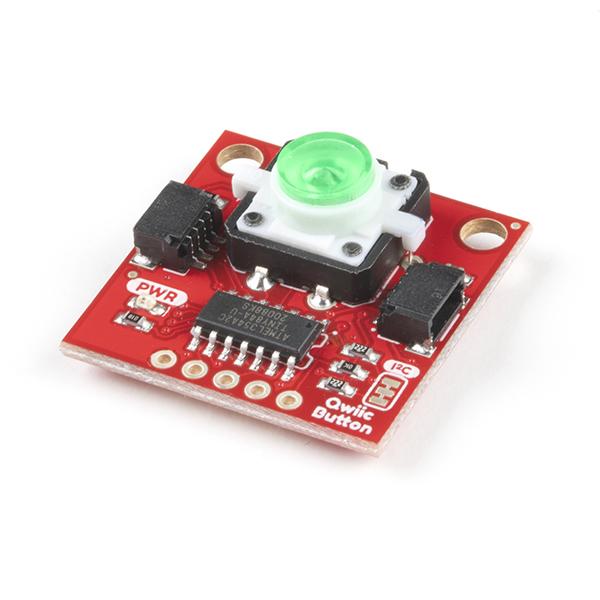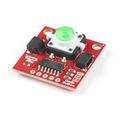SparkFun Qwiic Button - Green LED

Description Links Attachments
The Qwiic Button is perfect for projects requiring multiple buttons. Each button has a configurable I2C address, allowing you to chain multiple buttons over Qwiic and address each one individually. The Arduino library provides an easy way to configure your Qwiic Button to any I2C address you desire.
The Qwiic Button not only handles blinking and debouncing but also features configurable interrupts that can be set to activate upon a button press or click. The button also has an onboard FIFO queue that records when the button was pressed. This allows your microcontroller to save processing time as it doesn't need to constantly check the status of the button, but can run a small function whenever the button is pressed or clicked.
The Qwiic Connect System is a network of I2C sensors, actuators, shields, and cables designed to make prototyping faster and less prone to error. All Qwiic-enabled boards use a common 1mm pitch, 4-pin JST connector, which reduces the amount of required PCB space. The polarized connections also mean you can't connect it incorrectly.
The 12mm Green LED Button is rated for 50mA and its built-in LED can be configured to your desired level of blinkiness. If green isn't your color, the SparkFun Qwiic Button Breakout allows you to add a button of another color. The button comes with a schematic, Eagle Files, board dimensions, a hookup guide, an Arduino library, a Python package, a register map, and a GitHub hardware repo.
Properties
| Brand | Sparkfun |
| Model | BOB-16842 |
| More info | SparkFun Qwiic Button Hookup Guide - SparkFun Learn |
| Communication | I2C |
| Voltage | 3,3 V |
Alternative products
Customer questions
Customer Reviews
Suggested products
- In stock Opencircuit Micro USB cable 50 cm blue € 1,50 View product
- Opencircuit Gift card View product
- In stock Adafruit DS1307 Real Time Clock Assembled Breakout Board € 9,50 View product
- Sparkfun Qwiic Cable - Breadboard Jumper (4-pin) € 2,95 View product
- Opencircuit LM2937-3.3V LDO Spanningsconverter - SOT223 € 2,45 View product
- In stock SparkFun Qwiic HAT for Raspberry Pi € 8,75 View product
- Adafruit LSM6DSO32 6-DoF Accelerometer and Gyroscope € 15,50 View product
- Cytron 10Amp 7V-30V DC Motor Driver for R/C (2 Channels) € 41,75 View product
- In stock DFRobot Gravity: Digital piranha LED module - Blue € 3,60 View product
- In stock DFRobot Gravity: Digital White LED Light Module € 2,70 View product
- Sparkfun Battery Holder - 2xAA (JST-PH) € 2,90 View product
- In stock Sparkfun Resistor 1K Ohm 1/4 Watt PTH - 20 pack (Thick Leads) € 2,15 View product
- DFRobot Gravity: 2.0 Inch IPS Color Serial Display with I2C & UART (Support micro:bit & MakeCode Graphical Programming) € 18,50 View product
- In stock Raspberry Pi Pico 2 W € 9,25 View product
- ACT USB-C Hub 3.2 with 4 USB-A ports € 15,30 View product
- In stock Sparkfun Copper Tape - Conductive Adhesive, 5mm - 15 meter € 7,75 View product
- In stock Sparkfun Hobby Motor - Gear € 3,50 View product
- In stock Sparkfun Teensy Stackable Header Kit (Extended) € 2,90 View product
- In stock Sparkfun Battery Holder 2xAA with Cover and Switch - JST Connector € 2,60 View product
- Sale In stock -72 % Sparkfun EasyDriver - Stepper Motor Driver € 21,25 € 6,05 View product
- In stock Sparkfun Thin Speaker - 4 Ohm, 2.5W, 28mm € 3,- View product
- In stock Sparkfun Toggle Switch € 3,30 View product
- In stock Sparkfun Clear Plastic Knob € 1,75 View product
- In stock Sparkfun Resistor 1K Ohm 1/4 Watt PTH - 20 pack (Thick Leads) € 2,15 View product
- In stock SparkFun Logic Level Converter - Bi-Directional € 5,15 View product
- In stock SparkFun Serial Basic Breakout - CH340G € 11,50 View product
- In stock SparkFun Audio Jack Breakout € 2,- View product
- In stock Sparkfun LED - Ultraviolet € 2,15 View product
- In stock Sparkfun Super Capacitor - 10F/2.5V € 6,25 View product
- In stock SparkFun Nano Power Timer - TPL5110 € 10,95 View product










